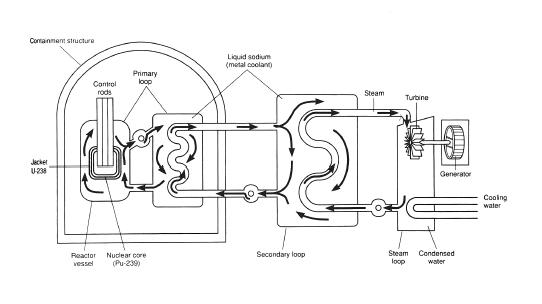|
This section contains 378 words (approx. 2 pages at 300 words per page) |
The liquid metal fast breeder reactor (LMFBR) is a nuclear reactor that has been modified to increase the efficiency at which non-fissionable uranium-238 is converted to fissionable plutonium-239, which can be used as fuel in the production of nuclear power. The reactor uses "fast" rather than "slow" neutrons to strike a uranium-238 nucleus, resulting in the formation of plutonium-239. In a second modification, it uses a liquid metal, usually sodium, rather than neutron-absorbing water as a more efficient coolant. Since the reactor produces new fuel as it operates, it is called a breeder reactor.
The main appeal of breeder reactors is that they provide an alternative way of obtaining fissionable materials. The supply of natural uranium in the earth's crust is fairly large, but it will not last forever. Plutonium-239 from breeder reactors might become the major fuel used in reactors built a few hundred or thousand years from now.
However, the potential of LMFBRs has not as yet been realized. One serious problem involves the use of liquid sodium as coolant. Sodium is a highly corrosive metal and in an LMFBR it is converted into a radioactive form, sodium-24. Accidental release of the coolant from such a plant could, therefore, constitute a serious environmental hazard.
 Liquid metal fast breeder reactor. (McGraw-Hill Inc. Reproduced by permission.)
Liquid metal fast breeder reactor. (McGraw-Hill Inc. Reproduced by permission.)
In addition, plutonium itself is difficult to work with. It is one of the most toxic substances known to humans, and its half-life of 24,000 years means that its release presents long-term environmental problems.
Small-scale pilot LMFBR reactors have been tested in the United States, Saudi Arabia, Great Britain, and Germany since 1966, and all have turned out to be far more expensive than had been anticipated. The major United States research program based at Clinch, Tennessee, began in 1970. By 1983, the U. S. Congress refused to continue funding the project due to its slow and unsatisfactory progress.
See Also
Nuclear Fission; Nuclear Regulatory Commission; Radioactivity; Radioactive Waste Management
Resources
Books
Cochran, Thomas B. The Liquid Metal Fast Breeder Reactor: An Environmental and Economic Critique. Baltimore: Johns Hopkins University Press, 1974.
Mitchell III, W., and S. E. Turner. Breeder Reactors. Washington, DC: U.S. Atomic Energy Commission, 1971.
Other
International Nuclear Information System. Links to Fast Reactor Related Sites. June 7, 2002 [June 21, 2002].
|
This section contains 378 words (approx. 2 pages at 300 words per page) |


